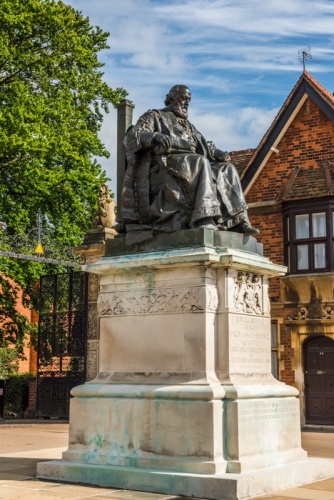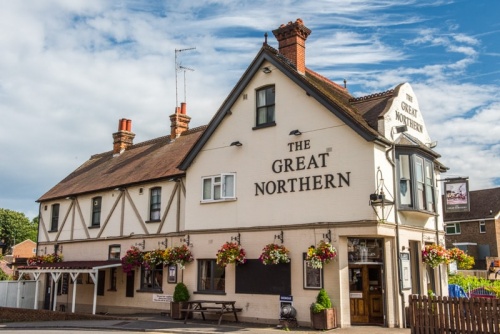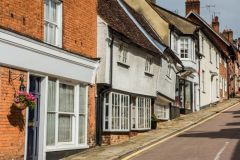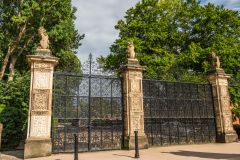
The small Hertfordshire town of Hatfield has a history beginning in the depths of the Saxon era. The first recorded mention of the name comes in AD 680 when a Synod of Hatfield is documented, though it isn't clear if the Synod was held at Hatfield or at Hatfield Chase.
History
In AD 970 King Edgar granted the manor here to the Abbey of Ely. after the Norman invasion of England in 1066, the manor was transferred to the Bishop of Ely, which accounts for the town's alternate name of Bishop's Hatfield during the medieval period.
The town was mentioned in the Domesday Book of 1086 when it was recorded as Hetfelle, meaning a pasture. No evidence of the Saxon settlement remains, but we know that there was a church, probably built of timber, dedicated to the 7th century Saxon princess St Etheldreda.
That timber church was rebuilt in the 13th century, with the addition of a striking 15th-century tower to give us the parish church of St Etheldreda that we see today.
Hatfield's status rose with its link to the powerful Bishops of Ely, and the town was granted the right to hold a fair on the feast of St Etheldreda, the patron saint of Ely. Etheldreda's more popular name was Audrey, and the fairs on St Audrey's feast day are said to have given us the word 'tawdry' (try saying St Audrey quickly with an emphasis on the 'T' in Saint).

In 1479 Bishop Morton began building a Bishop's Palace uphill of the parish church. The Palace was used not only as a residence but a place to hold banquets. It was also an important status symbol, an indication of the wealth and prestige of the powerful Bishops of Ely.
A Royal Residence
After the Dissolution of the Monasteries under Henry VIII Hatfield became a crown possession. Henry's eldest daughter Mary lived at Hatfield as a Princess Royal until Henry divorced her mother Catherine of Aragon. Henry then raised the infant Princess Elizabeth and her younger brother Edward at the old Bishop's Palace at Hatfield.
Princess Elizabeth learned of her sister Mary's death while reading a book under a tree in the park of Hatfield House. She immediately appointed William Cecil, her steward at Hatfield, as her royal secretary, and she held her first court in the Great Hall of the Old Palace.
The royal connection to Hatfield changed in 1603 when the new king, James I, visited Robert Cecil, Lord Salisbury, at his house of Theobalds, between Cheshunt and Waltham Cross. The king was so smitten with Theobalds that he proposed an exchange of the house for his manor of Hatfield. Cecil could not refuse the king, so he wisely agreed to the exchange.

From that day to this the Cecil family have made Hatfield House their home. Robert Cecil was not content with the medieval Bishop's Palace. He had it torn down, saving only one wing, and used the building material to create the present Hatfield House, a superb example of Jacobean architecture and one of the great stately homes of England.
Hatfield's location on the main route north from London made it a popular stopover place for travellers. One of those travellers was novelist Charles Dickens, who set a scene in his novel Oliver Twist in the Eight Bells pub. It was to the Eight Bells that Bill Sikes fled after murdering Nancy, and here that a pedlar offered to remove the bloodstains from Bill's hat.
Hatfield was transformed in 1850 with the arrival of the Great Northern Railway line from London to York. Hatfield was one of the original stops on the GNR, and the prosperity brought by the railway prompted rapid growth. A 'new' Hatfield was built, separate from the Old Hatfield area near the Cecil's mansion. This new area of the town was, not surprisingly known as Newtown and spread west from the railway station.
Curiously, Newtown Hatfield was itself swept away and completely rebuilt in the 1950s, so what we see today is the second 'New' Hatfield and the original medieval Old Hatfield.

A Tale of Two Prime Ministers
Hatfield has a close connection with two Prime Ministers of Britain (and if you count William Cecil and Robert Cecil, who fulfilled a similar role before the office of Prime Minister existed, you could say that 4 PMs are closely linked to this one Hertfordshire town). The first was William Lamb, 2nd Viscount Melbourne, who served two terms as PM under Queen Victoria and was her first Prime Minister. Viscount Melbourne lived at Brocket Hall in Hatfield and lies buried in the family vault near the pulpit of St Etheldreda's Church.
The second Prime Minister linked to Hatfield is Robert Arthur Talbot Gascoyne-Cecil, 3rd Marquess of Salisbury, who was Queen Victoria's last Prime Minister. He served three times as PM and four times as Foreign Secretary from 1885-1902. Like Viscount Melbourne, he is buried in St Etheldreda's Church, where his richly decorated altar tomb stands near that of an earlier Cecil, Robert Cecil, the 1st Lord Salisbury. A statue of the Marquess of Salisbury stands outside the elegant gates of Hatfield House.
Hatfield has a long connection with aeronautics and aviation history. The De Havilland Company developed their most famous aeroplanes here, including the Mosquito and the Comet, the world's first jet airliner. The De Havilland School of Flying opened at Hatfield Airfield in 1930. The Iraqi Flying Corp (1931) was launched from Hatfield as was the Egyptian Air Force (1932).

The King's Cup Air Race was held at Hatfield from 1933-1938 and the De Havilland Aircraft Company was based here from 1934. The Company established an Aeronautical Technical School that later became the Hatfield Polytechnic and still later was transformed into the University of Hertfordshire.
Though the modern Newtown area of Hatfield isn't terribly exciting for visitors, the Old Hatfield area, centred around Hatfield House and St Etheldreda's Church, is well worth exploring. There are several interesting old buildings ranging from the timber-framed cottages at the bottom of the churchyard to several old inns.
One of the more unusual sights in Hatfield is a viaduct across Park Street. There's nothing terribly exciting about a Victorian viaduct, except that this one was built for the sole purpose of making it easier for Lord Salisbury to reach the railway station from his home of Hatfield House.

Chequers Hotel
Across from the Eight Bells inn is the former Chequers Hotel. In the 17th century, the Hotel landlord was Thomas Serin, who issued the Hatfield Half Penny, or Serin Half Penny Token. At that time small denomination coins were in short supply so tradesmen and merchants often issued their tokens, which could be used locally or often, only at the place of issue. Not surprisingly the use of tokens was eventually suppressed but the Serin Half Penny was one of the most popular in the Hatfield area.
One of the most unusual street names in Hatfield is Arm and Sword Yard, which links the Great North Road and Park Street. The odd name is actually quite descriptive, for this alley was home to several butcher shops and a slaughterhouse. The lane was even more colourfully known as Bug Alley, and Blood and Gut Alley
On Fore Street, opposite the churchyard, is an elegant Georgian building that was once the Salisbury arms coaching inn. You can see the large archway for coaches (now blocked up). Look closely and you can see that some of the window openings have been blocked up to avoid paying window tax. Also on Fore Street is Crown House, built in 1495 according to a plaque on the door.
About Hatfield, Hertfordshire
Address: A1000,
Hatfield,
Hertfordshire,
England
Attraction Type: Town
Location: Signposted from J2 or J3 of the A1(M). There are numerous public car parks. The oldest section of town is near Hatfield House (follow the obvious signs).
Website: Hatfield, Hertfordshire
Location map
OS: TL225075
Photo Credit: David Ross and Britain Express
HERITAGE
 We've 'tagged' this attraction information to help you find related historic attractions and learn more about major time periods mentioned.
We've 'tagged' this attraction information to help you find related historic attractions and learn more about major time periods mentioned.
Find other attractions tagged with:
NEARBY HISTORIC ATTRACTIONS
Heritage Rated from 1- 5 (low to exceptional) on historic interest
Hatfield, St Etheldreda's Church - 0.9 miles (Historic Church) ![]()
Hatfield House - 0.9 miles (Historic House) ![]()
Mill Green Mill & Museum - 1.7 miles (Museum) ![]()
St Albans South Signal Box and Railway Museum - 4.4 miles (Museum) ![]()
Devil's Dyke, Wheathampstead - 4.5 miles (Prehistoric Site) ![]()
St Albans, St Peter's Church - 4.6 miles (Historic Church) ![]()
Sopwell Nunnery - 4.7 miles (Abbey) ![]()
St Albans Clock Tower - 4.9 miles (Historic Building) ![]()
Nearest Holiday Cottages to Hatfield, Hertfordshire:
Holmer Green, Buckinghamshire
Sleeps: 8
Stay from: £2188 - 7160
Biggleswade, Bedfordshire
Sleeps: 4
Stay from: £356 - 1504
More self catering near Hatfield, Hertfordshire











